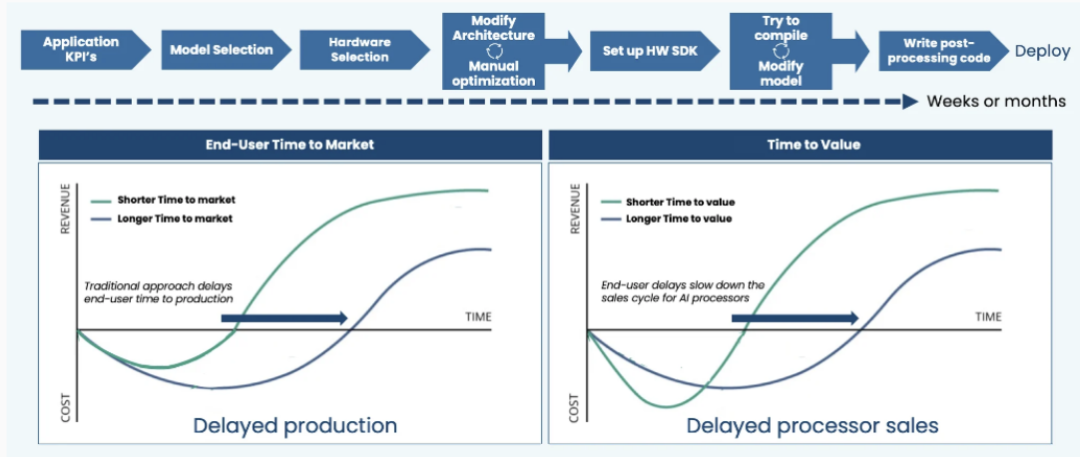Recently, the news of STMicroelectronics’ (ST) acquisition of the Canadian AI startup Deeplite has attracted industry attention.Deeplite claims to be the DeepSeek of edge AI, with unique technologies in model optimization, quantization, and compression that enable AI large models to run faster, smaller, and more energy-efficiently on edge devices.
Since DeepSeek popularized distilled models, more people have begun to focus on the deployment of AI large models at the edge. In the past, TinyML has also been very popular in the MCU field. Now, edge AI is advancing faster, and the market is heading towards an explosion.
ST’s Ambition: Building Advanced Edge AI Systems
ST’s recent acquisition of Deeplite is due to the strong synergy between the two companies: Deeplite’s technology for optimizing, quantizing, and compressing deep learning models will undoubtedly accelerate the adoption of ST’s first high-performance STM32N6.
When deploying deep learning models commercially, a major challenge is their operational scale, processor count, and power consumption intensity. Deeplite addresses this issue by providing an automated software engine to optimize DNN (Deep Neural Network) models, enabling AI for edge computing on any device.
Interestingly, Deeplite’s products can be described as AI nesting dolls, using AI to automatically make other AI models faster, smaller, and more energy-efficient, thereby creating highly compact, high-performance deep neural networks for deployment on edge devices such as security cameras, sensors, drones, smartphones, and vehicles.

This company gained significant attention early on, having been recognized as a leading edge AI innovator by Gartner, Forbes, Inside AI, and ARM AI.
The Deeplite project was launched in 2017 from the TandemLaunch incubator. In 2019, the project spun off from TandemLaunch to become an independent technology company. At that time, co-founders Dr. Ehsan Saboori, Davis Sawyer, and Nick Romano joined forces to bring AI into everyday life. Since the mid-2020 launch of Deeplite’s Neutrino™ software, there has been tremendous demand from major OEM brands, semiconductor, and application companies for Neutrino’s automated optimization engine. AI engineers can use this software within existing MLOps frameworks like PyTorch, ONNX, or TensorFlow to create highly compact, energy-efficient AI models, saving cloud costs and allowing new applications to run on battery-powered small edge devices. According to PitchBook, Deeplite has previously raised $6.47 million, with Canadian investors including BDC Capital, Desjardins Capital, and Somel Ventures.
In summary, ST’s overall ecosystem has seen significant enhancement. According to their official website, they not only possess powerful hardware MCUs and MPUs but also a robust software ecosystem.
Qualcomm Acquires Star Company: A Significant Step Forward
In March of this year, Qualcomm announced its acquisition of the edge AI development platform Edge Impulse, hoping to expand its AI capabilities for IoT-supporting products. Reports indicate that this acquisition is expected to complete in a few weeks and will retain the Edge Impulse brand.
Partnering with Qualcomm will accelerate support for Qualcomm’s Dragonwing processors, but Edge Impulse’s platform will continue to be open to MCU, CPU, GPU, and NPU users from the company’s hardware partners. Edge Impulse will maintain its current website (branded as “Edge Impulse, a Qualcomm company”).
The Qualcomm Dragonwing processor features on-device AI inference, computer vision, graphics, and processing capabilities. Edge Impulse currently supports the Dragonwing QCS6490 and QCS5430 processors and plans to add support for other Dragonwing processors for industrial and embedded IoT applications.
Edge Impulse’s position in the embedded space is not to be underestimated. The Edge Impulse development platform includes tools for data collection and preparation, model training, deployment, and monitoring, with minimal or no-code interfaces. Developers use Edge Impulse’s platform to add AI capabilities such as computer vision, time-series data, audio event detection, and speech recognition to embedded systems in asset tracking and monitoring, manufacturing, anomaly detection, and predictive maintenance systems.
Many people have heard of Edge Impulse, but few may have delved deeply into it. This company offers TinyML (Tiny Machine Learning) as a service and was founded in 2019 by Zach Shelby and Jan Jongboom, both from Arm, dedicated to providing the latest machine learning tools to enable all businesses to create smarter edge products. According to financial databases, the company has raised over $50 million. In the $34 million Series B funding round in 2021, it was valued at $234 million.
Edge Impulse solutions are widely used by health wearables manufacturers such as Oura, Know Labs, and NOWATCH, industrial organizations like NASA, and top chip suppliers, adopted by over 80,000 developers, and have become a trusted platform for enterprises and developers.
While it is not the only TinyML software solution provider, it has a relatively intuitive and user-friendly web interface, meaning it can be used simply by opening a webpage, and most importantly, it is free for developers.
Notably, Edge Impulse features an Edge Optimized Neural (EON) compiler. According to its official website, neural network inference models compiled with this compiler can use 25-55% less RAM and 35% less storage space compared to TFLite Micro.
Additionally, Edge Impulse has published technical validation articles on its official blog, utilizing their Digital Signal Processing (DSP) Block for pre-processing sound before inference, achieving faster and more accurate inference. For example, in bird song recognition, speed improved by 48%, and accuracy increased by 7%.
NXP Acquires NPU Company: Redefining the Smart Edge
In February of this year, NXP’s acquisition also caused a stir in the industry. At that time, NXP announced that it had reached a final agreement to acquire Kinara, an industry leader in high-performance, energy-efficient, and programmable discrete neural processing units (NPU).
These devices support a wide range of edge AI applications, including multimodal generative AI models. This acquisition will be an all-cash transaction valued at $307 million, expected to close in the first half of 2025, subject to customary closing conditions, including regulatory approvals.
Kinara is a U.S. semiconductor company founded in 2013 by Rehan Hameed, Wajahat Qadeer, and Jason Copeland, initially named Core Viz, later renamed Deep Vision, and in 2022 rebranded as Kinara.
Kinara’s discrete NPUs (including Ara-1 and Ara-2) are industry leaders in performance and energy efficiency. This makes them the preferred solution for emerging AI applications driven by vision, speech, gestures, and various other generative AI implementations. Both devices feature innovative architectures that support mapping inference graphs for efficient execution on Kinara’s programmable proprietary neural processing units, maximizing edge AI performance. This programmability ensures that AI algorithms can adapt as new methods evolve from CNNs to generative AI and agent AI.
Ara-1 is the first-generation discrete NPU, achieving performance of Resnet50-v1: 100 inferences/sec, MobileNet-v1: 554 inferences/sec, with latency of Resnet50-v1: 10 msec, MobileNet-v1: 1.8 msec, and power consumption of 1.7W @ 600MHz, packaged in a 15 mm x 15 mm EHS-FCBGA.
Ara-2 is the second-generation NPU, capable of achieving up to 40 TOPS of performance, optimized for high-performance generative AI systems. Specifically, it achieves performance of Stable Diffusion 1.4: 7 secs/image, LLaMA-7B: 12 output tokens/sec, MobileNetVl SSD: 974 1PS (1.03 ms latency), with power consumption under 2 Watts, and storage upgraded to 16 GB LPDDR4 (X), packaged in a 17 mm x 17 mm FCBGA.
On the software side, Kinara’s AI software development kit (SDK) optimally applies trained AI models to Ara-1 and Ara-2 silicon and modules. Kinara’s fully programmable computing engine allows our model compiler to quickly adapt to an almost unlimited range of neural network architectures.

The Ambition of Edge AI
In the AI community, there has always been a myth that “bigger is stronger.” However, while large models are beneficial, they are not very practical.
Experts have repeatedly predicted that the world does not need too many large models because they consume too much power; the real place for AI to take root is at the edge and on the client side.
Predictions indicate that by 2025, 75% of data will be processed at the edge, and the market potential for edge AI MCUs is enormous.
These three transactions highlight two important trends: first, AI/ML technologies are now an essential part of the hardware and software stack in embedded system design; second, as part of their AI strategy, chip manufacturers will increasingly provide complementary tools for their semiconductor devices to meet the comprehensive needs of embedded AI/ML learning. Therefore, more such transactions are expected in the future.
Other major MCU manufacturers are also continuously acquiring startups in this field and actively preparing for competition. For example, Renesas Electronics acquired Reality AI, Infineon acquired Sweden’s Imagimob, and NXP launched machine learning software eIQ and AI toolchain NANO. This indicates that the demand for edge AI computing is rapidly growing, and MCUs, as core components of edge devices, will play a crucial role in this trend.
It is evident that edge AI will be a battleground for MCUs in the coming years. As MCU manufacturers welcome their new CEOs, the competition among these companies may continue to intensify.
References
[1]EETimes:https://www.eetimes.com/qualcomm-hopes-to-expand-its-intelligent-iot-with-edge-impulse-acquisition/
[2]EDN:https://www.edn.com/why-embedded-chipmakers-are-acquiring-ml-software-firms/
[3]Semicone:https://www.semicone.com/article-200.html
[4]NXP:https://www.nxp.com/company/about-nxp/newsroom/NW-AI-PR-2025
[5]Kinara:https://kinara.ai/
[6]DeepLite:https://www.deeplite.ai/
· END ·
Follow the subscription account of EEWorld: "Robot Development Circle"
Reply "DS" to receive the complete version of "DeepSeek: From Beginner to Expert"

Scan to add the assistant and reply “Robot”
Join the group to exchange experiences face-to-face with electronic engineers
